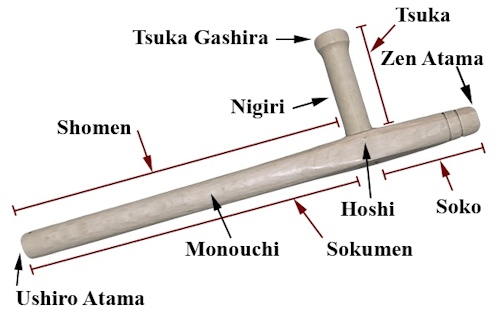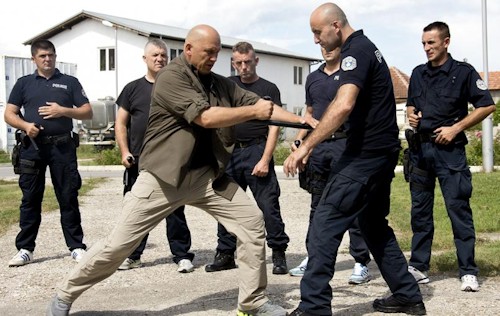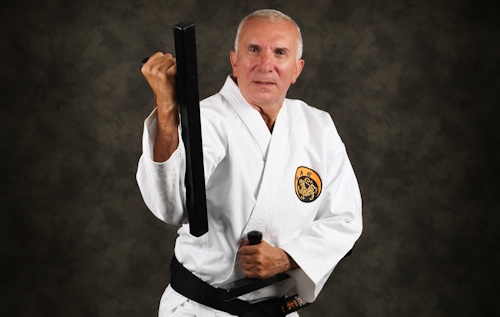It has become quite common nowadays to observe that a certain number of police forces of Western countries (as well as of Armed Forces when employed in "crowd control" or "anti-turnaround" activities) are provided with a special stick which is challenged thanks to a cross handle (inserted at three-quarters of its length) in such a way as to be easily used, as well as a stick, also as a protection to defend the forearm or body: in Japanese the name of this stick is "Tonfa" .
The Tonfa has a unique history that originated from the south of Japan, in the small island of Okinawa where in the medieval period it was initially used as an "agricultural tool", ie as a handle to turn the stone wheels of grain mills. Only later, through the complex historical events that affect the archipelago of Okinawa (the island of Okinawa and its smaller islands were annexed to Japan only in 1879), the Tonfa will then be used differently, becoming, in expert hands, a true and own impact weapon suitable for striking, blocking, fracturing ... but also suitable for immobilizing or strangling. The historical vicissitudes of the medieval Okinawan period sometimes show some differences due to the lack of certain written references and partly due to the desire to keep secrets on a number of indigenous issues. In any case, the island of Okinawa was for a long time a nodal center of trade and various influences coming from the farthest parts of Asia.

Thanks to these continuous exchanges, including cultural exchanges, on Okinawa island, the martial art of Okinawa-te (the "Okinawa hand"), also known as Totè (the "Chinese hand"), became famous around the 15th century. later with the name of Karate-do ("the art of the empty hand" or "disarmed").
Always on the island of Okinawa, following alternate events and the prohibition of the use of weapons on its territory, were born, presumably towards the sixteenth century, other martial disciplines that used simple agricultural tools that were transformed, thanks to the skill with which they were handled, in real weapons (which in Okinawa will always remain linked to the practice of Karate). The set of these martial arts, which used "improper weapons", was called "Kobudo" (Ko = minor, small, Budo = martial arts), or "minor Budo" to differentiate it from the "Budo" itself, ie 'set of traditional Japanese martial arts, including those with weapons.
The question is clearer if it is interpreted through the famous "Bushido" (Bushi = warrior, do = spiritual path / art), the ancient and rigorous ethical-moral code of the professional warrior, ie considering the difference between "Budo" and " Bugei ": Budo is the practice of martial arts to achieve its own balanced lifestyle through a rigorous inner discipline and a meticulous and intense physical training, while the bugei represents the practice of martial arts with lethal purposes for the exclusive use on the battlefield. Incidentally, given the high effectiveness of warfare of Okinawa Karate, in the 1939 Dai Nippon Butokukai of Tokyo (in this case, in its particular role as Military Training Center) decreed the official ascription of Karate in the "Japanese Martial Arts", thus creating the Japanese "Karate-do".

Although Okinawa has been Japanese for more than a century, the difference between Okinawan Karate and Japanese Karate still remains, as the many styles that are derived from it still suffer from initial differences, both from a technical and a tactical point of view. . In any case, the Tonfa, as a combat instrument (generally used in pairs) is included in the "Weapons of Kobudo" of Okinawa, in which there are also other former agricultural tools (some of which appropriately modified) such as sticks, sticks articulated, sickles, billers, tridents and chains as well as fishing gears such as reeds and oars. Some weapons of the Kobudo, including the Tonfa, also went to supplement the already nurtured arsenal of non-conventional weapons available to the Ninja, the famous "stealthy Warriors" or "Shadow Warriors".
Although not well known the ways with which in the past the Tonfa has spread in the eastern countries is still present in almost the Far East under different names, the most common are: "Kuai" in China, "Topang" in Indonesia, Malaysia and Singapore, "Moc-Can" in Vietnam and Laos, "Mai sok san" in Thailand.
The Tonfa consists of an elongated body (monouchi / yoka), generally of a length of 50-60 cm., On which a handle (tsuka), of variable length 7-12 cm, is transversely engaged. The handle is fitted at the top of a knob (tsuka-gashira) that allows the handle to rotate quickly, without the Tonfa itself getting out of hand, or it can be used to hit (in some models the knob is pointed).

In the area of the grafting of the handle (hoshi) some Tonfa models (above all those supplied to the Polizie) present an enlargement of the monouchi which guarantees a further protection for the arm that holds the Tonfa as a violent stroke of a stick, even though it is saved it could slide the stick itself along the monouchi and fracture the bones of the wrist or hand. The monouchi section can be circular, semicircular, square, rectangular or polygonal: the edges guarantee the possibility of fracturing the bones with a relatively light Tonfa, while a circular section necessarily requires a heavier Tonfa. Some models of Tonfa of the past, presumably of the Malaysian Topang, also have very sharp blades (appropriately fixed in several points) in such a way as to make the "Battle Tonfa" a definitely lethal weapon.
The traditional Tonfa is built using oak, teak or fir wood while the modern Tonfa can be made of plastic or aluminum (weighted), carbon fiber or polycarbonate. For transportability models exist in which the monouchi is retractable or telescopic so as to ensure (to the wearer as a side weapon) the ability to sit in a vehicle without having to place it somewhere. On the merits, two American firms have particularly specialized in the sector of equipment for the Police Forces: the "Monadnock", which has patented the historian Tonfa model "PR-24 Police side arm baton", and the "ASP" (Armament Systems and Procedures Inc.), which has had significant results with the "ASP retractable Tonfa baton" model. As for the traditional Tonfa there are an infinite number of good Chinese and Pakistani companies that build them, but the most famous are the Japanese Tokaido (made in Japan) and Shureido (made in Japan-Okinawa !!), which still hold the best than you can have in the martial sector of Karate and Kobudo.
 The use of the Tonfa is developed starting from five types of handle:
The use of the Tonfa is developed starting from five types of handle:
- with a classic handle grip (tsuka hon kumi): holding the handle and almost making the monouchi adhere to the forearm (shomen - inner part of the monouchi) so as to allow the forearm protection itself in the event of a parade (with the sokumen - external part of the monouchi). With this grip the Tonfa can be employed by striking a stroke with the front part (atama / zen atama) or with the rear part (ushiro atama) of the monouchi or with the knob of the handle (tsukagashira);
- with classic reverse grip (gyaku hon kumi): gripping the handle, but having the monouchi on the thumb side of the hand; protects the upper / front part of the forearm (it is rarely used);
- with a classic grip but with the monouchi pointing forward (zenkutsu monouchi kumi);
- as a stick (soko kumi): holding the shorter part, with respect to the handle, of the monouchi (soko), leaving the handle oriented downwards;
- as a hammer (ushiro atama kumi): holding the Tonfa as if it were a hammer striking with the knob of the handle. With this grip the handle can also be used as a "hook" (kake tsuka) to grasp or approach.
 To pass from the "traditional grip" to the "hammer grip", a Tonfa (kumi kaeru) rotation is performed by a wrist click with the Tonfa rotation on the back of the hand that is resting on the shomen (farogaginosa explanation, actually more easy to do that to say!). But the most common aspect of the Tonfa, and also the most difficult, is its use in fast rotation. This technique has many names, but the best known is perhaps "Jigoku Guruma". It is a technique that requires a lot of training so that the Tonfa, rounded or angular, is able to "hit hard" and fracture. It is necessary to have perfect control of the grip, of the locking and of the release of the handle and moreover, it is necessary to be able to develop in a few movements a kinetic energy that produces a strong impact on the target. It is a game of contraction and relaxation of the arm and wrist muscles as well as the ability to stretch or retract the arm at the right time. The continuous repetition of the movement, even hundreds of times, will progressively increase both speed and power. In a nutshell, you will have the certainty of having a formidable "tool" for your hands only when the ability to turn the Tonfa quickly and energetically, as well as the ability to give a sharp and precise shot exactly at the desired point.
To pass from the "traditional grip" to the "hammer grip", a Tonfa (kumi kaeru) rotation is performed by a wrist click with the Tonfa rotation on the back of the hand that is resting on the shomen (farogaginosa explanation, actually more easy to do that to say!). But the most common aspect of the Tonfa, and also the most difficult, is its use in fast rotation. This technique has many names, but the best known is perhaps "Jigoku Guruma". It is a technique that requires a lot of training so that the Tonfa, rounded or angular, is able to "hit hard" and fracture. It is necessary to have perfect control of the grip, of the locking and of the release of the handle and moreover, it is necessary to be able to develop in a few movements a kinetic energy that produces a strong impact on the target. It is a game of contraction and relaxation of the arm and wrist muscles as well as the ability to stretch or retract the arm at the right time. The continuous repetition of the movement, even hundreds of times, will progressively increase both speed and power. In a nutshell, you will have the certainty of having a formidable "tool" for your hands only when the ability to turn the Tonfa quickly and energetically, as well as the ability to give a sharp and precise shot exactly at the desired point.

The type of training that requires the Tonfa is very similar, although much simpler, to that required for Karate: for this reason in Okinawa the practice of the two disciplines has always been strongly linked. In some schools even were allowed to get their hands on any weapon of the Kobudo only after acquiring the black belt of Karate.
The Tonfa are traditionally used in pairs, however in the modern context the use of a single Tonfa is undoubtedly more comfortable, more realistic and more feasible. It is however desirable, for those who must use the Tonfa by profession, to try to be "ambidextrous", or at least to be able to operate in an acceptable way even with the so-called "weaker arm".
Ultimately, the modern Tonfa has distant origins and a long history: a simple agricultural tool with an insignificant and coarse appearance that has come to us through the force of tradition and that the innovative capacity of man has once again succeeded in valuing.
Marco Bandioli (Karate - black belt 5 ° Dan)

(photo: web / author)












